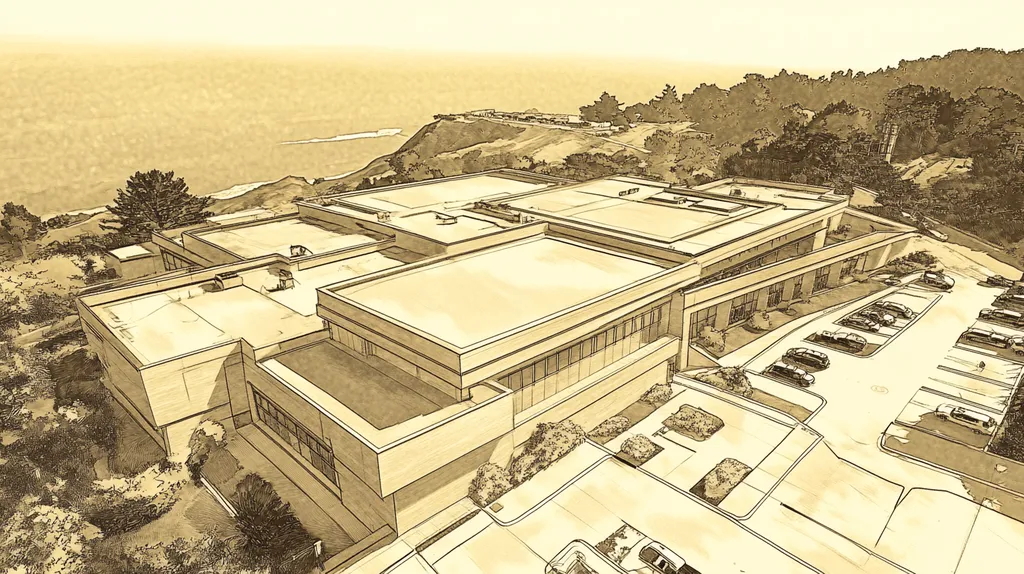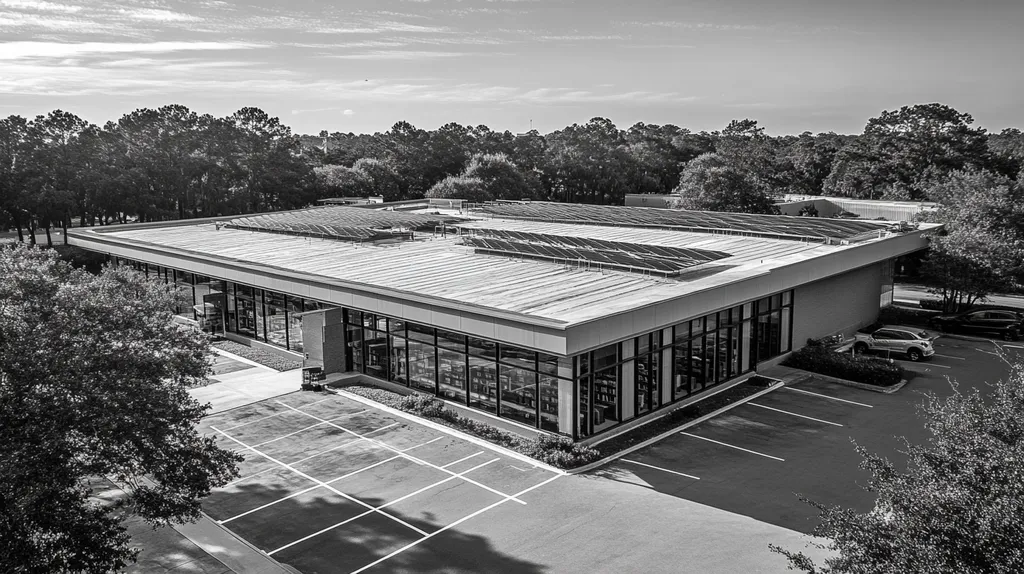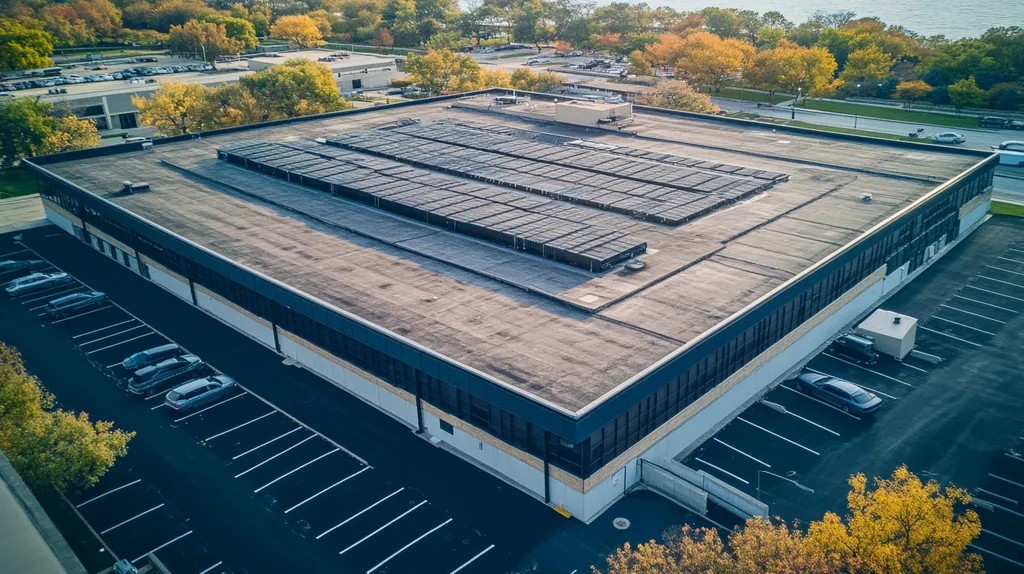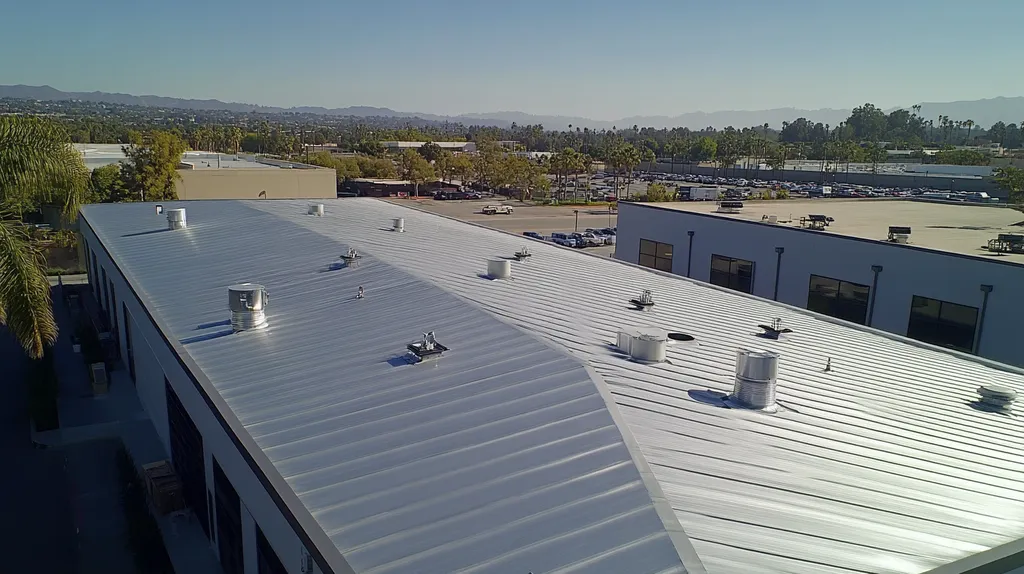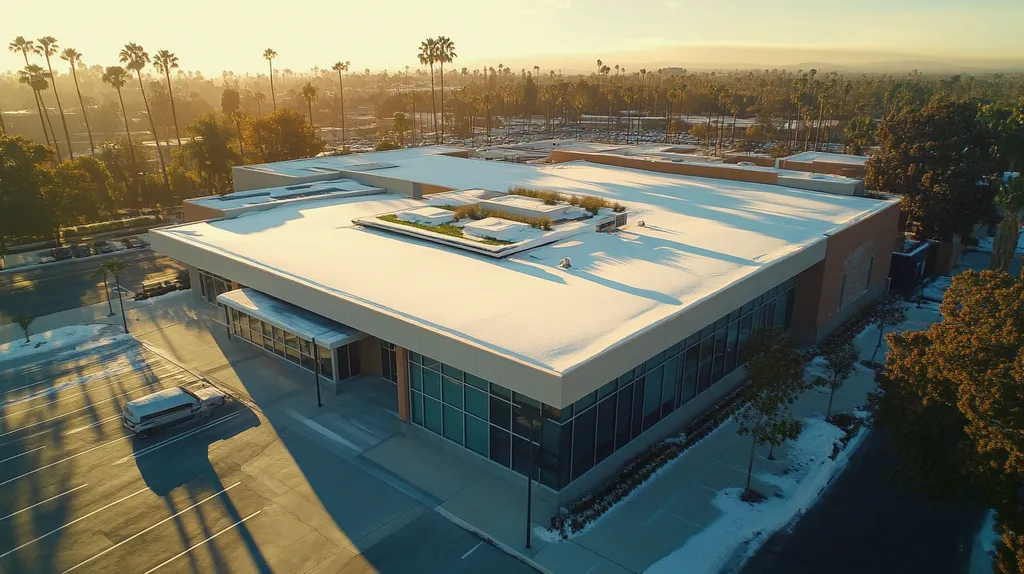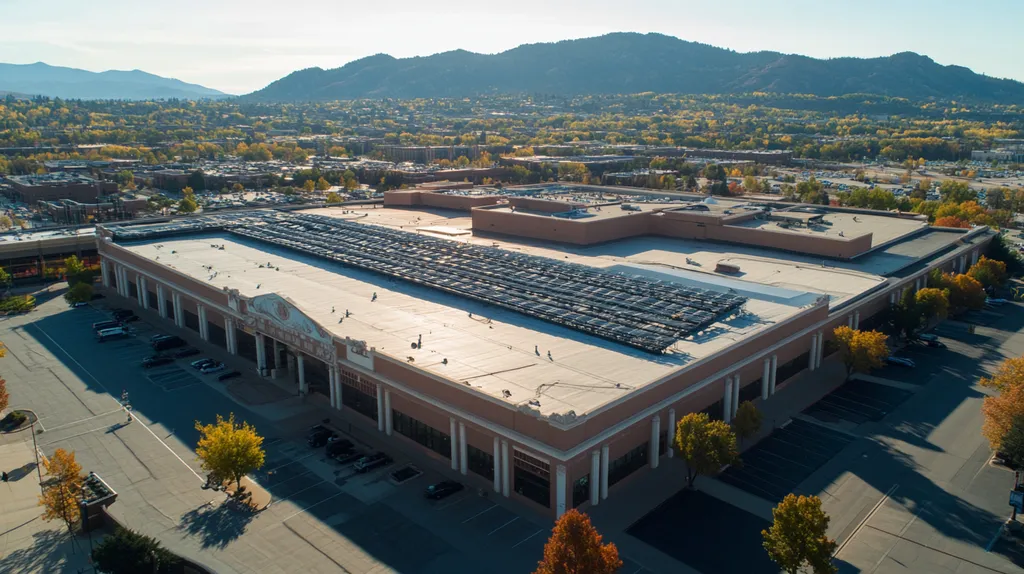Commercial roof installations can generate noise levels exceeding 95 decibels – equivalent to standing next to a motorcycle – creating severe disruption for building occupants and operations. Studies show that unmanaged construction noise reduces workplace productivity by up to 40% and frequently triggers lease terminations.
Modern noise control methods can reduce installation sound levels by 70% while maintaining project efficiency. However, most commercial roofing projects still rely on outdated practices that ignore critical acoustic principles.
This comprehensive guide examines the fundamentals of roof installation noise management, from material selection to implementation techniques, helping property managers protect both building operations and tenant satisfaction.
SECTION 1: FUNDAMENTAL CONCEPTS
Commercial roof installations generate significant noise that can severely impact building occupants and operations. Studies show that unmanaged construction noise can reduce workplace productivity by up to 40% and lead to tenant turnover. Understanding and controlling these acoustic challenges has become crucial for property managers, especially as more buildings maintain continuous operations during renovations.
Understanding Noise Sources in Roof Installation
The primary sources of roofing noise come from mechanical equipment, material handling, and installation processes. Heavy machinery like cranes and hoists create low-frequency vibrations that can travel throughout the building structure.
Impact noise from cutting, drilling, and fastening materials represents another major source of disruption. These high-frequency sounds are particularly problematic as they can penetrate through traditional building materials more easily.
Material transportation and staging activities generate intermittent noise peaks. The movement of pallets, dropping of materials, and operation of lifts create sudden sound spikes that can be especially disruptive to building occupants.
Weather conditions can amplify installation noise. Wind can create additional sound transmission paths, while temperature variations can affect how sound travels through building materials.
Acoustic Properties of Roofing Materials
Different roofing systems exhibit varying acoustic characteristics during installation. Single-ply membrane systems typically generate less installation noise compared to built-up roofing (BUR) or metal panel systems.
The density and mass of roofing materials directly affect their sound transmission properties. Heavier materials like concrete tile generally provide better sound insulation but require more intensive installation procedures.
Layered systems combining different materials can create acoustic barriers. The strategic use of sound-absorbing layers between structural components can significantly reduce noise transmission during installation.
Installation method selection impacts acoustic performance. Mechanically fastened systems typically generate more noise than adhered systems, though this difference must be balanced against other performance requirements.
Sound Transmission and Insulation Basics
Sound waves travel through both air and building structures, with different frequencies following distinct transmission paths. Understanding these pathways is crucial for effective noise control during installation.
Minimizing roof penetrations and properly sealing them with acoustical mastic can significantly reduce noise transmission. Adding mass to roof penetrations and ductwork further improves sound attenuation performance. (source: ASHRAE Journal)
The building’s structural composition affects sound transmission. Concrete decks typically provide better sound isolation than metal decks, though both can be enhanced with proper acoustic treatments.
Time and temperature can impact sound transmission characteristics. Installation noise tends to be more noticeable during early morning hours when ambient noise levels are lower and air density differences are more pronounced.
SECTION 2: SYSTEM COMPONENTS
Commercial roof installations produce noise levels that can reach 90 decibels or higher, creating significant disruption for building occupants and neighboring businesses. Understanding how different system components affect sound transmission is crucial for managing noise effectively. Modern roofing systems combine multiple layers and materials, each playing a distinct role in sound control during installation and throughout the roof’s lifespan.
Roofing Materials and Their Noise Characteristics
Different roofing materials exhibit distinct acoustic properties during installation. Metal panels typically generate the highest noise levels due to their resonant properties and installation methods requiring mechanical fastening.
Single-ply membranes offer better noise characteristics, especially when using adhered installation methods. The flexible nature of these materials helps dampen vibrations during the installation process.
Built-up roofing systems (BUR) present moderate noise levels during installation. The multiple layers of materials provide inherent sound dampening, though the equipment used for hot asphalt application can create significant noise.
Material thickness and density directly influence sound transmission. Heavier materials like concrete pavers provide superior sound isolation but require more intensive installation procedures.
Soundproofing Layers: Insulation and Underlayments
Insulation boards serve dual purposes in noise control, reducing both thermal transfer and sound transmission. High-density polyisocyanurate boards offer better sound dampening compared to standard density options.
Cover boards placed between insulation and the roofing membrane create an additional sound barrier. Gypsum-based products typically outperform fiber-reinforced options for noise reduction.
Underlayment selection significantly impacts installation noise levels. Synthetic underlayments generally produce less noise during installation than traditional felt products.
The combination and sequencing of these layers affect overall acoustic performance. Strategic layering can create multiple sound barriers that work together to reduce noise transmission.
Acoustic Barriers and Absorptive Panels
Temporary and permanent acoustic barriers play crucial roles in noise management. Lightweight PVC enclosures offer superior noise reduction while maintaining durability and aesthetic appeal.
The positioning of sound barriers significantly affects their performance. Angling barriers toward noise sources creates a ‘sound cove’ effect that contains unwanted noise more effectively. (source: AIL Sound Walls)
Absorptive panels installed around roof perimeters help prevent sound reflection. These panels can reduce noise levels by up to 20 decibels when properly positioned.
Modular barrier systems offer flexibility for different installation phases. These systems can be repositioned as work progresses to maintain optimal noise control throughout the project.
SECTION 3: IMPLEMENTATION METHODS
Effective noise control during commercial roof installation has become a critical business imperative. Studies show that unmanaged construction noise can reduce productivity by up to 50% in adjacent work areas and trigger lease terminations. Modern implementation methods focus on three key areas: specialized installation techniques, comprehensive sealing strategies, and advanced vibration control. These approaches work together to minimize disruption while maintaining roof system integrity.
Techniques for Installing Sound-Reducing Roof Systems
Sound-reducing roof systems require specialized installation approaches that differ from conventional methods. The sequence of material installation plays a crucial role in achieving optimal acoustic performance, with sound-absorbing layers needing precise positioning to maximize effectiveness.
Mechanical fastening patterns must be carefully planned to minimize sound transmission points. Using fewer fasteners at strategic locations can reduce noise bridges while maintaining structural integrity.
Installation timing can significantly impact noise levels. Scheduling intensive work during off-peak hours and coordinating with tenant operations helps minimize disruption to building occupants.
Modern installation equipment featuring noise-reduction technology can decrease sound levels by up to 30%. These tools, though initially more expensive, quickly pay for themselves through improved tenant satisfaction and reduced complaints.
Sealing and Gap Prevention to Minimize Noise Leakage
Proper sealing techniques represent a critical component of noise control during roof installation. Minimizing roof penetrations and sealing them with acoustical mastic can significantly reduce noise transmission, while adding mass inside roof curbs provides an enhanced sound barrier. (source: ASHRAE Journal)
Expansion joint details require special attention during installation. Using compressible foam fillers and flexible sealants helps maintain acoustic integrity while accommodating building movement.
Perimeter edge conditions present unique challenges for sound control. Installing continuous termination bars with proper sealant application helps prevent sound leakage at roof edges.
Regular inspection during installation ensures sealing integrity. Creating detailed quality control checklists specifically for sound-critical areas helps maintain consistent standards.
Using Damping and Vibration Control Technologies
Modern damping technologies significantly reduce structure-borne noise during installation. Isolation pads placed under equipment and work platforms can decrease vibration transmission by up to 70%.
Strategic placement of temporary sound barriers around work zones helps contain noise. Mobile acoustic screens can be repositioned throughout the project to maintain effective sound control.
Vibration-dampening fastener systems provide superior noise control compared to traditional methods. These specialized fasteners incorporate elastic elements that reduce impact noise during installation.
Advanced monitoring systems help track noise levels in real-time. This data allows contractors to adjust work practices immediately when sound thresholds are exceeded.
SECTION 4: MAINTENANCE REQUIREMENTS
The long-term effectiveness of noise control measures in commercial roofing depends heavily on proper maintenance. Studies show that poorly maintained acoustic elements can lead to a 15-20 decibel increase in noise transmission within just 2-3 years. This degradation not only impacts tenant comfort but can also violate local noise ordinances and trigger costly retrofits. Understanding and implementing proper maintenance protocols is essential for preserving both the structural and acoustic integrity of commercial roofing systems.
Inspecting Roof Components for Acoustic Integrity
Regular acoustic inspections should occur at least twice annually, with additional checks following severe weather events. These inspections must evaluate both the physical condition of materials and their sound-dampening performance.
Key inspection points include membrane seams, flashing details, and penetration seals. These areas are particularly vulnerable to degradation that can compromise acoustic performance.
Advanced imaging technology can identify gaps and moisture intrusion that may not be visible during visual inspections. Thermal scanning and ultrasonic testing help detect potential acoustic weak points before they become significant issues.
Documentation of inspection findings creates a valuable performance baseline. Tracking changes over time allows facility managers to identify emerging problems and plan preventive maintenance effectively.
Repairing and Replacing Insulation and Sealants
Maintaining proper insulation density and coverage is crucial for sustained acoustic performance. Even small areas of compressed or damaged insulation can create significant sound bridges through the roof assembly.
Installing silencers near rooftop HVAC units requires careful alignment and ongoing maintenance to prevent loss of sound attenuation due to operational wear. Regular checks ensure continued reduction of low-frequency noise common with rooftop equipment. (source: ASHRAE Journal)
Sealant replacement schedules should align with manufacturer recommendations. UV exposure and temperature cycling can degrade acoustic sealants faster than traditional roofing sealants.
When repairs are needed, using materials with equivalent or superior acoustic ratings maintains system performance. Mixing different types of insulation or sealants can create acoustic weak points.
Monitoring Noise Levels Post-Installation
Establishing a baseline noise measurement immediately after installation provides a reference point for future evaluations. Measurements should be taken under various weather conditions and times of day.
Regular acoustic testing helps verify that noise levels remain within specified limits. Using calibrated sound meters ensures accurate and consistent measurements across inspection periods.
Creating detailed noise maps of the roof surface identifies potential problem areas. These maps can guide maintenance efforts and help prioritize repairs.
Tenant feedback provides valuable qualitative data about system performance. Establishing clear communication channels for reporting noise issues helps facility managers respond proactively to acoustic concerns.
SECTION 5: PERFORMANCE METRICS
Effective noise control during commercial roof installation directly impacts tenant satisfaction, worker productivity, and regulatory compliance. Studies show that excessive construction noise can reduce workplace productivity by up to 45% and trigger lease terminations. Understanding and properly measuring acoustic performance helps facility managers make informed decisions about materials and installation methods while maintaining building operations.
Measuring Sound Transmission Class (STC) Ratings
Sound Transmission Class ratings provide standardized measurements of how well building materials block sound transmission. Higher STC ratings indicate better sound isolation properties, with most commercial building codes now requiring minimum STC ratings between 50-60 for roof assemblies.
Laboratory testing of roofing materials establishes baseline STC values that help predict real-world performance. These ratings become especially important when selecting materials for noise-sensitive facilities like hospitals, schools, or office buildings.
Field testing during installation verifies that assemblies meet specified STC requirements. Regular testing throughout the installation process allows for immediate corrections if sound transmission exceeds acceptable levels.
Environmental factors like temperature and humidity can affect STC performance. Testing under various conditions provides a more complete picture of acoustic behavior throughout the year.
Noise Reduction Coefficient (NRC) Evaluation
The Noise Reduction Coefficient measures how effectively materials absorb sound rather than reflect it. NRC ratings range from 0 to 1, with higher values indicating better absorption properties.
Silencers and proper duct design play crucial roles in reducing airborne sound, particularly for low-frequency noise from rooftop HVAC equipment. Careful attention to silencer selection and placement significantly improves overall acoustic performance. (source: ASHRAE Journal)
Different roofing materials exhibit varying NRC values depending on their composition and installation method. Understanding these differences helps optimize material selection for specific acoustic requirements.
Combining materials with complementary NRC ratings creates more effective sound control systems. Layered assemblies often provide better noise reduction than single-material solutions.
Assessing On-Site Acoustic Performance
Field testing during installation provides real-time feedback about acoustic performance. Using calibrated sound meters at multiple locations helps identify problem areas requiring immediate attention.
Weather conditions significantly impact on-site sound measurements. Testing should occur under various environmental conditions to ensure consistent performance year-round.
Creating detailed acoustic maps helps track performance across the entire roof surface. These maps highlight areas where additional sound control measures may be needed.
Documentation of field test results provides valuable data for future projects. Maintaining detailed records helps refine installation techniques and material selections over time.
SECTION 6: OPTIMIZATION STRATEGIES
Unoptimized commercial roof installations can generate noise levels exceeding 95 decibels, severely disrupting business operations and threatening tenant retention. Studies show that proper optimization strategies can reduce installation noise by up to 70% while maintaining project efficiency. Modern approaches combine advanced materials, strategic planning, and innovative installation methods to create comprehensive noise management solutions that protect both building operations and bottom-line results.
Integrating Layered Soundproofing Solutions
Multi-layer soundproofing systems represent the foundation of effective noise control during roof installation. Each layer serves a specific acoustic purpose, from impact absorption to airborne sound reduction, creating a comprehensive barrier against installation noise.
Strategic material combinations maximize sound reduction potential. High-density cover boards paired with acoustic membranes can reduce impact noise by up to 35 decibels compared to standard installations.
Installation sequencing plays a crucial role in layered system effectiveness. Proper overlap and joint staggering between layers prevents sound transmission paths that could compromise overall performance.
Quality control measures must verify proper integration between layers. Regular testing during installation ensures each component maintains its acoustic performance within the complete assembly.
Advanced Materials and Techniques for Noise Control
Modern acoustic enclosure systems offer superior noise reduction while maintaining practical installation requirements. Lightweight PVC barriers with specialized sound cove designs can effectively contain construction noise while allowing necessary workspace access. (source: AIL Sound Walls)
Vibration-dampening fastener systems significantly reduce impact noise during installation. These specialized components incorporate elastomeric elements that absorb and dissipate sound energy before it enters the building structure.
Sound-absorbing temporary barriers provide flexible noise control during different installation phases. Mobile acoustic screens can be repositioned throughout the project to maintain optimal sound reduction where needed most.
Advanced adhesive systems eliminate mechanical fastening noise while maintaining system integrity. Low-noise application methods reduce disruption without compromising long-term performance.
Planning for Noise Management in Roof Design and Retrofit
Comprehensive noise management planning must begin during the initial design phase. Early consideration of acoustic requirements allows for optimal material selection and installation method coordination.
Building usage patterns should guide installation scheduling. Coordinating intensive work with tenant operations minimizes disruption while maintaining project efficiency.
Retrofit projects require special attention to existing conditions and constraints. Detailed site surveys help identify potential sound transmission paths that need additional treatment.
Performance monitoring protocols must be established before work begins. Clear metrics and testing procedures ensure noise control measures meet specified requirements throughout the installation process.
The Bottom Line
With commercial roof installation noise causing up to 40% productivity loss and increasing tenant turnover rates by 25%, implementing proper acoustic management is no longer optional – it’s a business imperative.
Modern noise control methods, when properly implemented, can reduce installation sound levels by 70% while maintaining project efficiency and roof system integrity.
Success requires an integrated approach combining appropriate material selection, strategic installation planning, and ongoing performance monitoring.
As building operations become increasingly continuous and noise regulations more stringent, property managers who fail to address installation acoustics risk significant financial impacts through lost tenants, reduced productivity, and compliance violations.
The tools, techniques, and technologies outlined in this guide provide a clear roadmap for managing roof installation noise effectively while protecting both building operations and bottom-line results.
FREQUENTLY ASKED QUESTIONS
Q. What noise sources impact commercial roof installation?
A. Major noise sources during commercial roof installation include mechanical equipment, cutting, and material handling. Heavy machinery creates vibrations, while high-frequency sounds from drilling can penetrate through walls, leading to disruption.
Q. How do roofing materials affect industrial roof noise?
A. Different roofing materials have varying noise characteristics; for example, metal panels tend to generate higher noise levels. In contrast, single-ply membranes offer better sound-dampening properties, especially when adhered.
Q. What methods help manage noise during commercial roof installation?
A. Effective methods include specialized installation techniques, comprehensive sealing strategies, and advanced vibration control. These approaches work together to lower the noise impact on building occupants.
Q. How often should I maintain my commercial roof’s noise control features?
A. Regular maintenance should occur at least twice a year, especially after severe weather. Inspections should focus on seals, membrane seams, and penetration points to ensure continued acoustic integrity.
Q. How do I measure construction noise levels on my industrial roof?
A. Measuring construction noise involves using calibrated sound meters at various locations. Regular testing under different conditions is essential to ensure compliance with noise regulations and tenant satisfaction.
Q. What are effective optimization strategies for reducing roofing noise?
A. Strategies include utilizing layered soundproofing solutions and advanced materials. These can significantly reduce noise levels while ensuring that the installation proceeds efficiently without disrupting building operations.
Q. How do tenant operations affect commercial roof installation schedules?
A. Tenant operations play a crucial role in scheduling installations. Planning intensive work during non-peak hours helps minimize disruption and maintains comfort for occupants, ultimately ensuring a smoother project.

